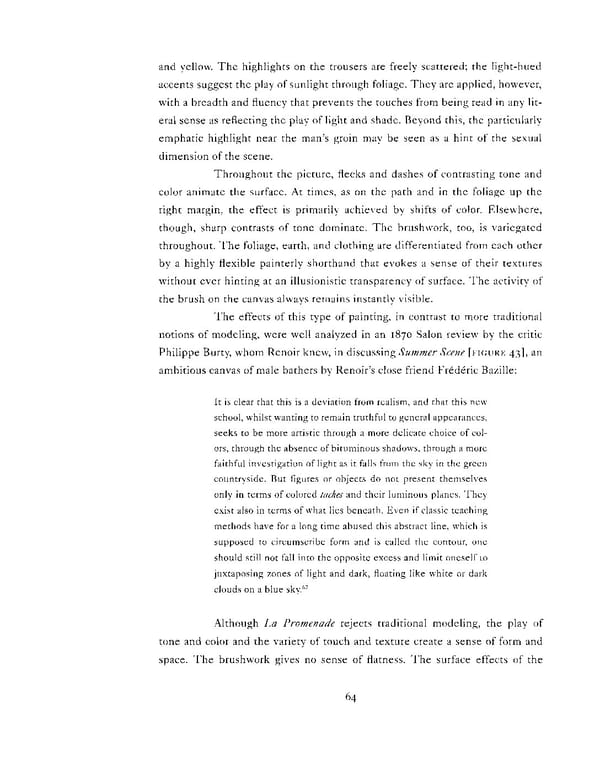and yellow. The highlights on the trousers are freely scattered; the light-hued accents suggest the play of sunlight through foliage. They are applied, however, with a breadth and fluency that prevents the touches from being read in any lit- eral sense as reflecting the play of light and shade. Beyond this, the particularly emphatic highlight near the man's groin may be seen as a hint of the sexual dimension of the scene. Throughout the picture, flecks and dashes of contrasting tone and color animate the surface. At times, as on the path and in the foliage up the right margin, the effect is primarily achieved by shifts of color. Elsewhere, though, sharp contrasts of tone dominate. The brushwork, too, is variegated throughout. The foliage, earth, and clothing are differentiated from each other by a highly flexible painterly shorthand that evokes a sense of their textures without ever hinting at an illusionistic transparency of surface. The activity of the brush on the canvas always remains instantly visible. The effects of this type of painting, in contrast to more traditional notions of modeling, were well analyzed in an 1870 Salon review by the critic Philippe Burty, whom Renoir knew, in discussing Summer Scene [FIGURE 43], an ambitious canvas of male bathers by Renoir's close friend Frederic Bazille: It is clear that this is a deviation from realism, and that this new school, whilst wanting to remain truthful to general appearances, seeks to be more artistic through a more delicate choice of col- ors, through the absence of bituminous shadows, through a more faithful investigation of light as it falls from the sky in the green countryside. But figures or objects do not present themselves only in terms of colored taches and their luminous planes. They exist also in terms of what lies beneath. Even if classic teaching methods have for a long time abused this abstract line, which is supposed to circumscribe form and is called the contour, one should still not fall into the opposite excess and limit oneself to juxtaposing zones of light and dark, floating like white or dark 67 clouds on a blue sky. Although La Promenade rejects traditional modeling, the play of tone and color and the variety of touch and texture create a sense of form and space. The brushwork gives no sense of flatness. The surface effects of the 64
 Pierre-Auguste Renoir: La Promenade Page 71 Page 73
Pierre-Auguste Renoir: La Promenade Page 71 Page 73